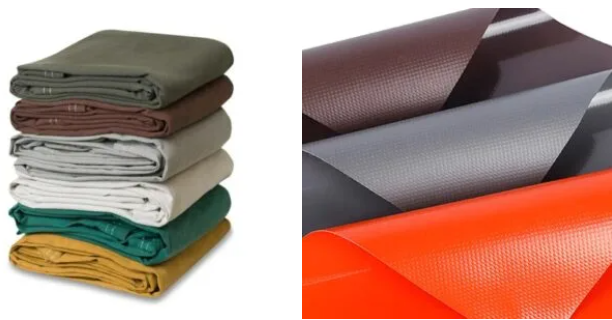
Camping is a fun and exciting way to connect with nature, but choosing the right tent fabric can make or break your outdoor experience. From staying dry during a sudden rainstorm to withstanding gusty winds, the fabric of your tent matters. In this guide, we’ll explore the most popular tent fabrics—Canvas, PVC, Nylon—and help you pick the best one for your next adventure. Plus, we’ll share some insider tips about outdoor fabric and waterproof fabric. Let’s dive in!
🏕️ Why Does Tent Fabric Matter?
Tent fabric is the backbone of your camping shelter. It protects you from the elements, provides insulation, and ensures durability. Different types of fabrics come with their own strengths and weaknesses, so understanding their features is crucial. Let’s break them down one by one.
🌟 Popular Tent Fabrics and Their Features
1. Canvas Fabric
Canvas is a classic choice for tents and has been used for centuries. Made from cotton or a cotton-polyester blend, it’s known for its durability and breathability.
Pros:
- Breathable: Reduces condensation inside the tent.
- Durable: Long-lasting and resistant to wear and tear.
- Temperature Regulation: Keeps you warm in winter and cool in summer.
Cons:
- Heavy: Not ideal for backpacking.
- Absorbs Moisture: Can get heavy when wet if not treated.
Canvas is a fantastic option for car camping or longer stays in one place. For waterproof canvas fabric, look for options with a special coating.
2. PVC Fabric
PVC (Polyvinyl Chloride) is a synthetic fabric commonly used for tents, tarpaulins, and banners. One well-known supplier of PVC fabric is DER Fabric, which specializes in durable outdoor materials.
Pros:
- Waterproof: Perfect for rainy conditions.
- UV Resistant: Protects against harmful sun rays.
- Affordable: A cost-effective choice.
Cons:
- Not Breathable: Can lead to condensation inside the tent.
- Heavy: Heavier than other fabrics like nylon.
PVC fabric is great for those who need a waterproof tent or are camping in wet climates. It’s also easy to clean, making it a low-maintenance choice.
3. Nylon Fabric
Nylon is one of the most popular materials for modern camping tents. Lightweight and versatile, it’s ideal for backpackers and hikers.
Pros:
- Lightweight: Easy to carry on long treks.
- Waterproof Coatings: Often treated to repel water.
- Affordable: Budget-friendly option.
Cons:
- UV Damage: Can weaken with prolonged sun exposure.
- Less Durable: Prone to tearing compared to canvas.
If you’re heading out for a lightweight camping trip, nylon fabric is a top choice. Look for reinforced nylon with ripstop technology for added durability.
📊 Comparison Table: Tent Fabrics at a Glance
|
Fabric Type |
Best For |
Pros |
Cons |
Ideal Use |
|
Canvas |
Long-term camping |
Durable, breathable, temp regulation |
Heavy, absorbs moisture |
Car camping, festivals |
|
PVC |
Rainy conditions |
Waterproof, UV resistant, affordable |
Not breathable, heavy |
Wet climates, tarpaulins |
|
Nylon |
Backpacking |
Lightweight, water-resistant |
Prone to tearing, UV damage |
Hiking, lightweight trips |
🛠️ Key Factors to Consider When Choosing Tent Fabrics
1. Durability
If you’re camping in rugged terrains, choose durable fabrics like canvas fabric or reinforced nylon fabric. They can withstand rough handling and harsh weather.
2. Waterproofing
For rainy or snowy weather, opt for waterproof fabric like PVC or treated nylon. Waterproofing ensures you stay dry no matter the conditions.
3. Weight
Backpackers should prioritize lightweight materials like nylon, while car campers can manage heavier options like canvas or PVC.
4. Breathability
Breathable fabrics like canvas are ideal for reducing condensation, especially in humid climates.
5. Budget
PVC fabric is budget-friendly, while high-quality canvas and reinforced nylon might be more expensive but offer better longevity.
🌟 Why DER Fabric Stands Out
If you’re considering PVC fabric, DER Fabric is a trusted name in the industry. Known for its durable and high-quality outdoor materials, DER Fabric provides waterproof fabric and PVC tarpaulin ideal for camping and other outdoor uses. Their expertise in fabric production ensures you get the best value for your money.
🚀 Tips for Maintaining Your Tent Fabric
- Clean After Every Trip: Remove dirt and debris to avoid damage. Use mild soap and water for cleaning.
- Store Properly: Make sure your tent is completely dry before packing it to prevent mold or mildew.
- Reapply Waterproof Coatings: Over time, even waterproof fabrics can lose their effectiveness. Reapply a waterproof spray when needed.
- Avoid Direct Sunlight: Prolonged exposure to UV rays can damage most fabrics. Use a tarp or place your tent in a shaded area.
🌈 Final Thoughts
Choosing the right tent fabric doesn’t have to be complicated. Whether you go for the classic durability of canvas fabric, the waterproof reliability of PVC fabric, or the lightweight convenience of nylon fabric, there’s an option for every camper. Understanding your needs—weather conditions, weight preferences, and budget—will guide you to the perfect choice.
So, pack your bags, grab your favorite tent, and get ready for an adventure. Happy camping! 🏞️
❓ FAQs
1. Which fabric is best for camping in the rain?
PVC fabric or treated nylon is best for rainy conditions as they are waterproof and reliable.
2. Can I make a nylon tent more durable?
Yes, look for reinforced ripstop nylon or use a tent footprint to reduce wear and tear.
3. How do I waterproof my canvas tent?
Apply a waterproofing spray designed for canvas fabric before your trip.
4. What’s the difference between canvas and nylon tents?
Canvas tents are durable and breathable but heavy, while nylon tents are lightweight and less durable.
5. Is PVC fabric eco-friendly?
PVC fabric isn’t the most eco-friendly option, but it is durable and long-lasting, reducing waste over time.








Leave a Reply